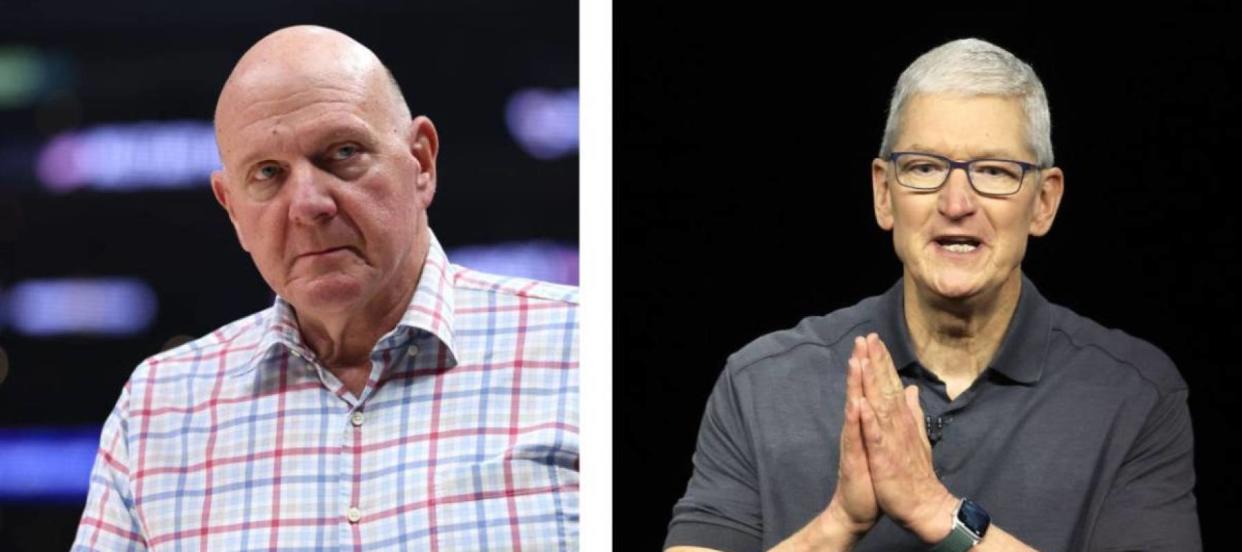Steve Ballmer and Tim Cook are the 'rarest' type of ultra-rich in America — here's what makes them so unique and what you can learn from these 2 'hired-hand' billionaires

Everyone loves a get-rich-quick story, but what about a slow-burn-to-riches story? As it turns out, a slow climb to billionaire status is far less common.
Forbes discovered that those who worked their way to the top — aka. “hired-hand billionaires” or “corporate ladder billionaires” — are the least likely of all the rich folk to land a spot on the publication’s list of the world’s richest people.
Don’t miss
Commercial real estate has beaten the stock market for 25 years — but only the super rich could buy in. Here’s how even ordinary investors can become the landlord of Walmart, Whole Foods or Kroger
Inflation is still white-hot in 2024 — use these 3 'real assets’ to protect your wealth today, no matter what the US Fed does or says
Anything can happen in 2024. Try these 5 easy money hacks to help you make and save thousands of dollars in the new year (they will only take seconds)
Almost the entire 760 American billionaires that appeared on the Forbes list are either founders (69%), such as Jeff Bezos and Mark Zuckerberg, or heirs (27%), such as the Mars or Walton families. If you do the math, you’ll realize that those names made up a whopping 96% of the list.
The awkward leftovers are just 26 people: the “corporate ladder billionaires.” This exclusive club includes former Microsoft CEO Steve Ballmer and Apple CEO Tim Cook.
Most of us aren’t company founders or wealthy heirs. But is it possible to maximize your 9-to-5 and reach the top of the corporate ladder to become a billionaire?
Make your money make money
Steve Ballmer is currently worth $120.5 billion, according to Forbes. But when he started working at Microsoft in 1980, he was nowhere near that wealthy. In fact, The Washington Post once reported that Ballmer made $50,000 a year back then (which is $184,874.04 today).
Even though he was low on the corporate ladder, The Washington Post also noted that Ballmer knew how valuable his 5-10% company shares were — especially the longer he stayed with Micosoft. So, Ballmer slowly worked his way up the ladder and eventually became CEO of the company in 2000.
However, Ballmer knew that Microsoft wasn’t the only place where he could make money. Forbes reported that, when he retired in 2014, he used his Microsoft salary and shares to make even more money by buying the L.A. Clippers for $2 billion.
Forbes estimated that the team has now doubled in value and is worth $4.65 billion today.
Sure, most of us won't be able to amass the funds needed to buy a professional sports team, but one of the keys to accumulating wealth is turning your paycheck into more money.
It’s not just for billionaires like Ballmer. It’s how teachers become millionaires in their retirement: they diligently invest in their 401(k)s every month and let their wealth compound over time. You can do the same.
Read more: Thanks to Jeff Bezos, you can now cash in on prime real estate — without the headache of being a landlord. Here's how
Find a (lucrative) passion project
Tim Cook is currently worth $2.1 billion, according to Forbes. But what netted him all that wealth had nothing to do with money.
“Don't work for money, it will wear out fast, or never be enough,” he advised students at the University of Glasgow in 2017.
Cook has mentioned various iterations of the “do what you love” mantra on several occasions, according to Inc. We can probably take this to mean that he wouldn’t have stayed in his role as Apple CEO if he didn’t love it.
After all, between filling Steve Job’s shoes and dealing with government crackdowns on Apple, Cook’s job is no walk in the park. If he was only in it for the money, he likely would have quit by now (although his $2.1 billion fortune probably makes his stay a little easier).
Other billionaires have also said that passion is key to their success. Two of these passionate guys are Warren Buffett and Bill Gates. They both believe that if they hadn’t kept up their respective interests in investing and computers since they were kids, they would never be the billionaires they are today.
What to read next
Rich young Americans have lost confidence in the stock market — and are betting on these 3 assets instead. Get in now for strong long-term tailwinds
Robert Kiyosaki warns 401(k)s and IRAs will be 'toast' after the 'biggest crash in history' — protect yourself now with these shockproof assets
Credit card debt under inflation's shadow: The 4 potent weapons you need to have for a strong financial resurgence
This article provides information only and should not be construed as advice. It is provided without warranty of any kind.
